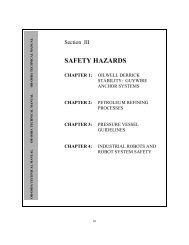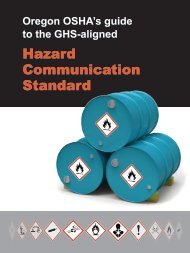Asbestos - Rules of Abatement - Oregon OSHA
Asbestos - Rules of Abatement - Oregon OSHA
Asbestos - Rules of Abatement - Oregon OSHA
You also want an ePaper? Increase the reach of your titles
YUMPU automatically turns print PDFs into web optimized ePapers that Google loves.
Exposure monitoring<br />
Employee exposure measurements must be made from breathing zone air<br />
samples representing the eight-hour TWA and 30-minute short-term exposures<br />
for each employee.<br />
Employers must take one or more samples representing full-shift exposure to<br />
determine the eight-hour TWA exposure in each work area. To determine shortterm<br />
employee exposures, employers must take one or more samples representing<br />
30-minute exposures for the operations most likely to expose employees<br />
above the excursion limit in each work area.<br />
Employers must allow affected employees and their designated representatives<br />
to observe any employee exposure monitoring. When observation requires<br />
entry into a regulated area, the employer must provide and require the use <strong>of</strong><br />
protective clothing and equipment.<br />
Periodic monitoring<br />
For Class I and II jobs, conduct daily monitoring that is representative <strong>of</strong> the<br />
exposure <strong>of</strong> each employee working in a regulated area, unless a negative exposure<br />
assessment for the entire operation already exists and nothing has changed. When<br />
all employees use supplied-air respirators operated in positive-pressure mode,<br />
employers may discontinue daily monitoring. If employees are performing Class I<br />
work using control methods not recommended in the standard, employers must<br />
continue daily monitoring, even when employees use supplied-air respirators.<br />
For operations other than Class I and II, employers must monitor all work in<br />
which exposures can exceed the PEL <strong>of</strong>ten enough to validate the exposure<br />
prediction. If periodic monitoring shows employee exposures below the PEL<br />
and STEL, the employer may discontinue monitoring.<br />
Additional monitoring<br />
Changes in processes, control equipment, level <strong>of</strong> personnel experience, or<br />
work practices that could result in exposures above the PEL or STEL —<br />
regardless <strong>of</strong> a previous negative exposure assessment for a specific job —<br />
require additional monitoring.<br />
Medical surveillance<br />
Employers must provide a medical surveillance program for all employees:<br />
• Who are or will be exposed to asbestos at or above the PEL or STEL for<br />
a total <strong>of</strong> 30 or more days per year and engage in Class I, II, or III work.<br />
(Note: The 30-day requirement excludes days in which less than one<br />
hour is spent in Class II or III work when work practices specified by the<br />
code are followed.)<br />
• Who wear negative-pressure respirators<br />
12
















